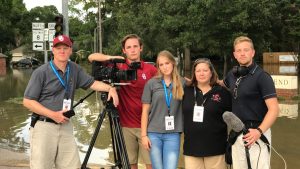
TUSCALOOSA, Ala. — Dr. Chandra Clark, assistant professor of journalism and creative media at The University of Alabama, traveled to Houston in the wake of Hurricane Harvey to document the local news coverage of the historic storm event.
Clark spent much of the week before following reporters on social media, and researching and mapping out stories and locations. Each day before the trip, she and her colleague, Scott Hodgson of the University of Oklahoma, would conference call with the National Association of Broadcasters and the Broadcast Education Association, planning coverage and establishing contacts for stories.
Their purpose was not to cover Hurricane Harvey so much as it was to cover those who covered Hurricane Harvey.
From Sept. 3-9, Clark and her team conducted 48 interviews with full production setups at television and radio stations in Houston and Beaumont.
These stories illustrate the role of communication from federal, state and city leaders to broadcasters, and how crucial radio and television are in the process of getting information to viewers and listeners in a real-time situation with lives on the line.
The team documented the 2011 EF4 tornado which affected Tuscaloosa, the 2012 hurricane known as “Superstorm Sandy,” and a 2013 EF5 tornado which struck Moore, Oklahoma.
“These videos go to the White House, they are shown in Congressional hearings and to the FCC,” said Clark. “When media organizations are looking for funding for broadcast initiatives, this work demonstrates the indispensable role that radio and television broadcasters play during natural disasters.”
They spoke with several families in Houston who lost their homes, but they also captured a typically untold story: the personal damage the storm had upon the broadcasters.
“During the time of a natural disaster or breaking news, the audience doesn’t always realize the hazards happening behind the scenes for reporters, producers and managers,” said Clark. “In a case like this, news personnel are living in the community they are serving, and some of them lost their homes just like their neighbors. So, they are going through the same situations as the people they are reporting on whether or not they talk about it on the air.”
Several broadcasters lost their homes while rescuing and helping their neighbors and friends. Many of them worked 3-4 days straight will little to no sleep, helping with rescues and giving out crucial information the public needed to make informed decisions.
Clark invites her students to help with the project at the outset and in the editing process, for which they receive valuable experience and their name in the credits.
The entire process takes 2-3 months because of the enormity of the content and because the team works on the finished product as they collaborate between UA and the University of Oklahoma with shared, duplicate drives.
The National Association of Broadcasters is the voice for the nation’s radio and television broadcasters. As the premier trade association for broadcasters, NAB advances the interests of its members in federal government, industry and public affairs; improves the quality and profitability of broadcasting; encourages content and technology innovation; and spotlights the important and unique ways stations serve their communities. For more information, visit nab.org.
The department of journalism and creative media is a part of the College of Communication and Information Sciences.
Contact
Rand Nelson, 205-348-6416, james.nelson@ua.edu
Source
Dr. Chandra Clark, 205-348-2697, chandra.clark@ua.edu
